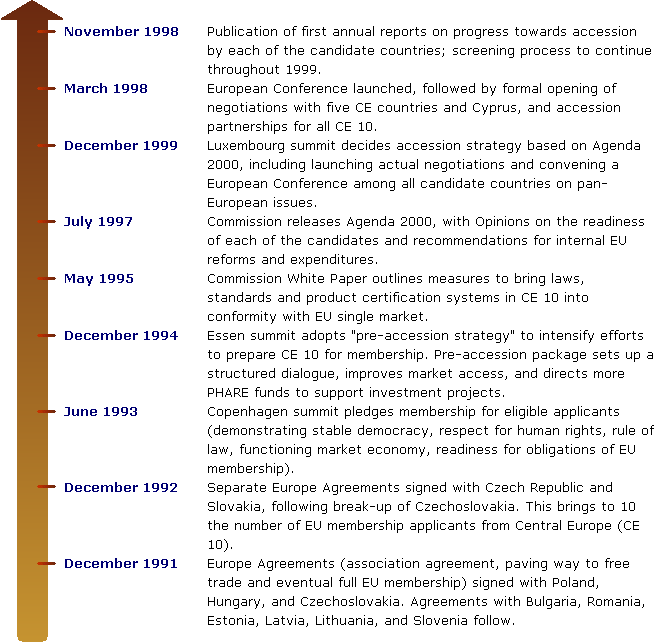
The European Integration |
The Origins of European Integration | ||
| EU Institutions | |||
| The Decision Making Process | |||
| EU Policies: from A to Z | |||
| The EU in the World | |||
EnlargementEnlargement is the process by which countries join the European Union (EU). So it is a familiar process - the EU has enlarged several times since the "Common Market" (European Economic Community) was set up with six Member States in 1957. Enlargements in 1973 (UK, Ireland and Denmark), 1981 (Greece), 1986 (Portugal and Spain) and 1995 (Austria, Finland and Sweden) have brought the EU to its current membership of 15. Future EU EnlargementIn March 1998 the EU opened talks on full membership with six Countries - Cyprus, the Czech Republic, Estonia, Hungary, Poland and Slovenia. Efforts were stepped up to help the remaining candidates prepare for membership. Although formal negotiations on membership began with only six countries, the EU emphasized that the process is inclusive. Other countries may catch up or overtake those beginning the negotiations if annual assessments by the Commission of the state of readiness of each country show that sufficient progress is being made. Joining a highly integrated Union is inherently complex, and most of the applicant countries must continue to make far-reaching economic, political and social adjustments following the end of communism. Inevitably, therefore the process will take much longer than the enlargement of NATO to some of the same countries in Central and Eastern Europe. In July 1997, the Commission completed an exhaustive review of the state of readiness of the applicant countries for full membership, publishing its findings in a three-volume report, known as Agenda 2000: For a Stronger and Wider Union. The Commission concluded that none of the 10 Central and East European applicants was ready for full membership under criteria adopted at the 1993 Copenhagen European Council, but five were sufficiently advanced along the path to open negotiations. Agenda 2000The purpose of Agenda 2000 was twofold: to prepare the candidate countries for membership and to prepare the EU and its institutions for the biggest and most challenging enlargement in its history. After two years of intensive debate, EU leaders meeting in Berlin in March 1999 approved the Agenda 2000 strategy. This includes reforms of the Common Agriculture Policy (CAP), the Structural Funds, the EU decision-making procedures, and a financial package for the years 2000-2006 in preparation for the enlargement. Timeline of EU enlargement
Cyprus, Malta and TurkeyNegotiations with Cyprus for membership of the EU began in March 1998, along with five countries from Central and Eastern Europe. The European Council decided in 1995 that the next phase of EU enlargement would include Cyprus and Malta. Malta's application was frozen by a new government in 1996 but reactivated after another change of government in September 1998. Although the EU has decided that Turkey does not yet meet all the criteria for full membership of the Union, it has frequently reaffirmed Turkey's eligibility for EU membership. Turkey applied for full membership in 1988, but the Commission recommended an alternative path, including steadily closer economic relations, a strategy that both sides are implementing. Since 1995, the EU and Turkey are joined in a Customs Union that provides for enhanced economic cooperation. An accompanying financial protocol has not yet been implemented, but efforts are continuing to bring it into force. In 1998, the EU invited Turkey to participate in the launch of a high level European Conference on issues including transnational organized crime, foreign and security policy, regional cooperation and economic and social policy. In August 1999, following a devastating earthquake in Turkey, the EU immediately responded with humanitarian assistance and a few moths later Turkey officially became an "applicant" to the EU accession. | |||
